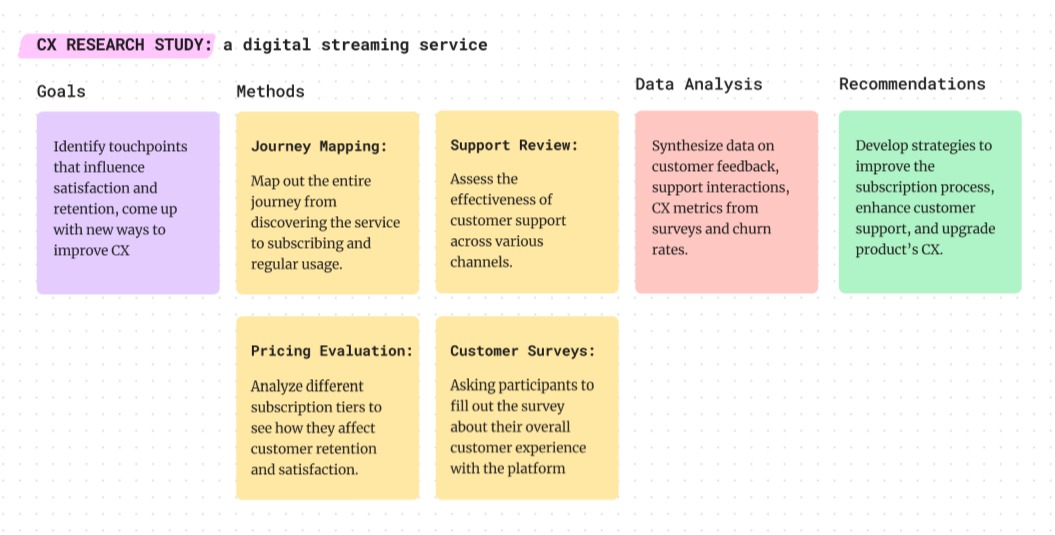The increasing importance of customer and user research leads companies to start implementing both in their strategy in order to stay on top of the markets. But how to use which and how to leverage them for maximum effectiveness? In this chapter, we are going to explain the nuances of CX vs. UX research and learn to apply them correctly.
Difference Between CX and UX Research
The main difference between customer CX and UX Research lies in the scope of their research.
Customer Experience Research (or CX Research) is the process of collecting insights about customers’ interactions with the company at all touchpoints and using them to pinpoint areas of improvement.
This kind of research aims to understand the process a customer goes through before, during, and after making a purchase or engaging with your product or service. It has a very broad spectrum and encompasses the whole customer journey.
User Experience Research (or UX Research), on the other hand, focuses on understanding user behaviors and interactions a customer has specifically with the product, particularly digital products like websites and apps. It focuses on the usability, accessibility, and the level of satisfaction provided in the interaction.
Here’s a quick comparison table of CX and UX Research:
Aspect | Customer Experience (CX) Research | User Experience (UX) Research |
Scope | Broad, covering the entire customer journey with a brand, including interactions across various channels and touchpoints. | Focused on specific interactions between a user and a product or service, often digital. |
Goals | To understand and improve the customer journey, focusing on customer satisfaction, loyalty, and advocacy. | To understand and enhance the usability, accessibility, and the level of satisfaction provided in the interaction with the product. |
Outcomes | Strategies to improve customer loyalty, brand perception, and overall customer satisfaction. | Insights to improve product design, functionality, and user satisfaction. |
Key Methods | Surveys, customer interviews, journey mapping, service blueprinting, sentiment analysis. | Usability testing, interviews, observations, A/B testing, task analysis. |
CX vs UX Research: Which Is Right For You?
CX and UX research are rather interconnected fields and they often overlap due to their common areas of interest. However, they are still very distinct in their goals and characteristics.
Here’s a quick overview of the benefits and use cases of each approach:
CX Research
- Provides a holistic view of customer’s journey and their interactions with the product across various touchpoints
- Helps to identify factors that influence customer loyalty and retention
- Pinpoints areas of improvement when it comes to customer experience and helps to come up with solutions to increase customer satisfaction
- Highlights how different aspects of a brand are perceived, impacting brand reputation and positioning
- Helps to align business goals with customers’ unique needs
Choose CX Research when you want to:
👉gather feedback on existing experiences and identify areas for improvement in the customer journey.
👉 track customer satisfaction and experience trends over time.
👉spot any critical customer experience issues that you could’ve overlooked
👉understand certain metrics like Net Promoter Score or Customer Satisfaction, why they are so low, or how to increase them
👉reduce churn and enhance customer loyalty
UX Research
- Focuses specifically on users’ interactions with the product, empathizing ease-of-use and usability
- Provides a good understanding of users’ needs, expectations and problems and helps to come up with effective solutions in terms of your product
- Ensures that the product meets users’ needs and provides exceptional user experience
- Assists in identifying usability issues and informs improvements
- Saves money by testing designs during the design phase, preventing untested products from moving to development.
Choose UX Research when you want to:
👉understand your users and how they interact with the product
👉pinpoint usability issues and roadblocks that keep users from having a smooth experience with your product
👉test prototypes with users before development in order to identify issues early in the design process and save costs on doing that later on
👉launch a new feature and understand how intuitive it is for the user
👉make your designs more engaging and user-friendly by collecting user feedback and implementing new changes
CX Research vs UX Research Questions

CX and UX Research questions have rather different focuses, with the first one reflecting the broader scope of customer experience while the second one aims at studying specific user-product interactions.
Let’s take a look at some of the questions each discipline aims to answer to better understand how they differ:
CX Research Questions
- How do customers perceive our brand as a whole?
- What are the main factors driving customer loyalty to our company?
- How satisfied are customers with our overall service, from initial contact to post-purchase support?
- Which touchpoints in the customer journey need improvement for better customer satisfaction?
- What are customers’ emotional responses to our marketing campaigns?
- How do customers rate their overall experience when interacting with our customer service?
- What factors influence a customer’s decision to recommend our brand to others?
UX Research Questions
- How easy is it for users to navigate our website/app?
- What challenges do users face when completing a purchase on our platform?
- How do users interact with the features of our mobile app?
- What are the common usability issues encountered by users in our software?
- How intuitive is the user interface of our product for first-time users?
- What improvements can be made to enhance the user interface and user experience of our digital products?
- How do specific design changes impact user satisfaction and task completion rate?
CX and UX Research Examples
To better understand the differences between CX and UX research, take a look at two examples below. They perfectly showcase the differences in the approaches and methods used for research, as well as their outcomes.
For this example, we’ll assume we are testing a digital streaming service. Here’s how the CX research would look like in that case:

The goal here is to improve the overall CX of the streaming platform.
It could come up as a result of low retention rates or customer complaints. Or maybe you’ve distributed a Customer Satisfaction survey and realized people could be more satisfied with the experiences you provide. Now you need to understand what’s causing the issue and where you can do better as a company.
Here’s where CX research comes in.
In this case, you’re using customer journey mapping, pricing evaluation, support reviews, and customer surveys to get a holistic perspective on the current CX situation and spot areas of improvement.
As a result of your CX research, you get enough information to understand the behavior of your customers, their expectations, and common issues they face. Based on that you’re able to create actionable strategies for optimizing CX, increasing customer satisfaction and retention levels.
Here’s how a UX Research study would look like in that case:

In the case of UX research, your goal is much more specific and product-oriented. You’re looking to improve the usability and UX or your streaming service because you’ve recently noticed users are facing issues with it’s design and functionality.
You’re using usability testing, interviews, and feature use diaries to understand how users interact with your streaming platform, where they face issues, what are their needs, and how you can satisfy them.
As a result of a UX research study you get a great overview of critical usability issues that need to be fixed, as well as uncover users’ hidden needs and pain points that you can tackle with your product to provide them a better experience.
Metrics for Success in CX and UX Research

Apart from the other distinctions of these two types of research, the metrics they use to measure success are also different.
As we already know from the previous chapter of our CX research guide, CX research metrics are more focused on measuring customer satisfaction, the efficiency of the support team, churn rates, etc.
UX research metrics, on the other hand, focus on evaluating the usability of the product, task success rates, the time it takes a user to complete a certain action with the product, etc.
Let’s take a look at some of the examples:
1. CX Research Metrics
- Net Promoter Score (NPS): measures the likelihood of a customer recommending a company, product, or service to others
- Customer Satisfaction Score (CSAT): measures short-term happiness with a product, service, or specific interaction.
- Customer Effort Score (CES): tracks the ease of customer interaction and problem-solving with a company.
- Time to Resolution: indicates the average amount of time it takes to resolve customer issues or support requests.
- First Contact Resolution: tracks the percentage of customer inquiries or issues resolved in the first interaction.
- Churn Rate: the rate at which customers stop doing business with a company.
2. UX Research Metrics
- Task Success Rate: shows whether users are able to successfully complete certain tasks with your product.
- Time-on-task: measures the amount of time it takes a user to complete a certain task.
- Error Rate: the number of times users did not manage to complete a task with your product
- Sustem Usability Scale (SUS): a questionnaire tool used to measure the perceived usability of an application.
- Single Ease Question (SEQ): helps to assess how easy each task was for the user to complete.
Wrapping Up
We hope that that quick comparison gave you a good overview of the distinctions and similarities between CX and UX Research. You can now strategically plan your research studies and prioritize the type of research that your company needs at the moment.
To support your research activities, make sure you have a good research tool at hand😉
UXtweak offers everything you need to conduct CX and UX research! Run surveys, conduct usability tests and interviews, analyze user behavior, and test prototypes – all within one tool!



